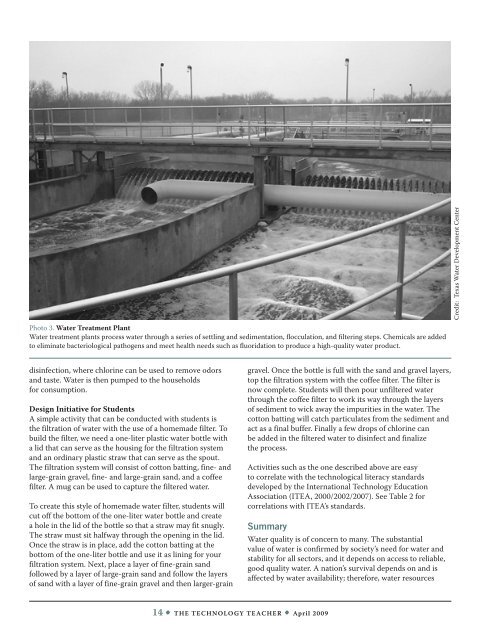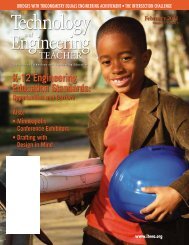Design Your Own Underwater ROV - International Technology and ...
Design Your Own Underwater ROV - International Technology and ...
Design Your Own Underwater ROV - International Technology and ...
You also want an ePaper? Increase the reach of your titles
YUMPU automatically turns print PDFs into web optimized ePapers that Google loves.
Credit: Texas Water Development Center<br />
Photo 3. Water Treatment Plant<br />
Water treatment plants process water through a series of settling <strong>and</strong> sedimentation, flocculation, <strong>and</strong> filtering steps. Chemicals are added<br />
to eliminate bacteriological pathogens <strong>and</strong> meet health needs such as fluoridation to produce a high-quality water product.<br />
disinfection, where chlorine can be used to remove odors<br />
<strong>and</strong> taste. Water is then pumped to the households<br />
for consumption.<br />
<strong>Design</strong> Initiative for Students<br />
A simple activity that can be conducted with students is<br />
the filtration of water with the use of a homemade filter. To<br />
build the filter, we need a one-liter plastic water bottle with<br />
a lid that can serve as the housing for the filtration system<br />
<strong>and</strong> an ordinary plastic straw that can serve as the spout.<br />
The filtration system will consist of cotton batting, fine- <strong>and</strong><br />
large-grain gravel, fine- <strong>and</strong> large-grain s<strong>and</strong>, <strong>and</strong> a coffee<br />
filter. A mug can be used to capture the filtered water.<br />
To create this style of homemade water filter, students will<br />
cut off the bottom of the one-liter water bottle <strong>and</strong> create<br />
a hole in the lid of the bottle so that a straw may fit snugly.<br />
The straw must sit halfway through the opening in the lid.<br />
Once the straw is in place, add the cotton batting at the<br />
bottom of the one-liter bottle <strong>and</strong> use it as lining for your<br />
filtration system. Next, place a layer of fine-grain s<strong>and</strong><br />
followed by a layer of large-grain s<strong>and</strong> <strong>and</strong> follow the layers<br />
of s<strong>and</strong> with a layer of fine-grain gravel <strong>and</strong> then larger-grain<br />
gravel. Once the bottle is full with the s<strong>and</strong> <strong>and</strong> gravel layers,<br />
top the filtration system with the coffee filter. The filter is<br />
now complete. Students will then pour unfiltered water<br />
through the coffee filter to work its way through the layers<br />
of sediment to wick away the impurities in the water. The<br />
cotton batting will catch particulates from the sediment <strong>and</strong><br />
act as a final buffer. Finally a few drops of chlorine can<br />
be added in the filtered water to disinfect <strong>and</strong> finalize<br />
the process.<br />
Activities such as the one described above are easy<br />
to correlate with the technological literacy st<strong>and</strong>ards<br />
developed by the <strong>International</strong> <strong>Technology</strong> Education<br />
Association (ITEA, 2000/2002/2007). See Table 2 for<br />
correlations with ITEA’s st<strong>and</strong>ards.<br />
Summary<br />
Water quality is of concern to many. The substantial<br />
value of water is confirmed by society’s need for water <strong>and</strong><br />
stability for all sectors, <strong>and</strong> it depends on access to reliable,<br />
good quality water. A nation’s survival depends on <strong>and</strong> is<br />
affected by water availability; therefore, water resources<br />
14 • The <strong>Technology</strong> Teacher • April 2009
















